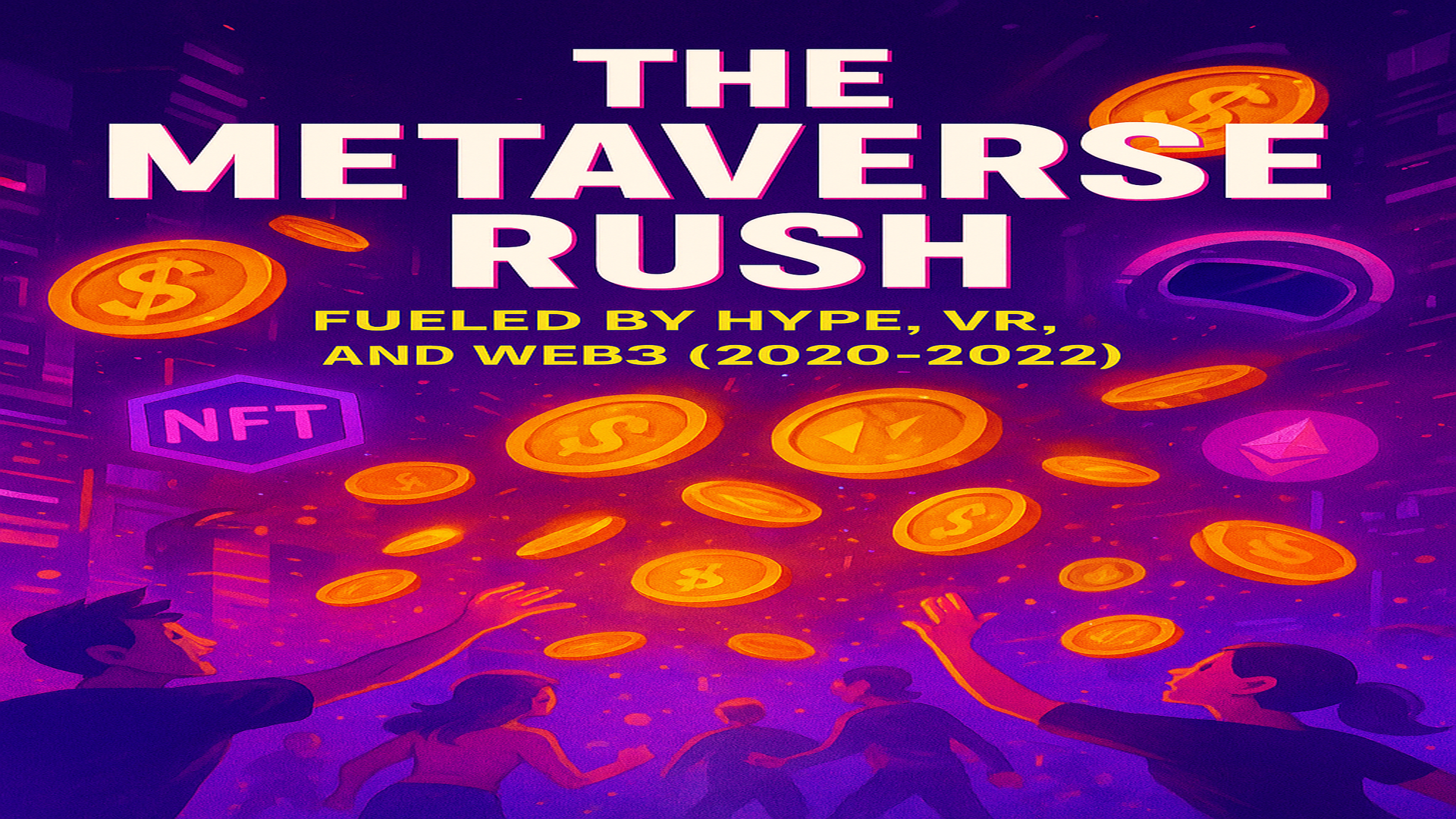The Metaverse Series - Article 05

The Metaverse Rush: A Second Boom Fueled by Hype, VR, and Web3 (2020–2022)
When the world locked down, the virtual world lit up, but not always for the right reasons.
After a quiet decade of development and niche innovation, the idea of the Metaverse exploded back into the mainstream consciousness in the early 2020s. This resurgence was driven not by a slow buildup of grassroots enthusiasm or revolutionary design improvements, but by a sudden confluence of technologies, social conditions, and market dynamics. Most notably: rapid advancements in Virtual Reality, the maturation of Web3 technologies, and the global disruption caused by the COVID-19 pandemic.
Suddenly, it seemed like everyone was talking about the Metaverse again. Venture capital flowed like water, startups appeared overnight, and the concept became so inflated that nearly any virtual experience was labeled a "Metaverse" product. But this second boom, much like the California Gold Rush of the 1800s, was more about speculation than substance.
COVID-19: A Global Catalyst
When COVID-19 forced billions of people indoors, the need for remote interaction became urgent. Work shifted to Zoom, education to Teams, and casual socialization to platforms like Discord and online games. In this environment, the idea of persistent virtual worlds regained traction.
The Metaverse promised a solution to digital fatigue: immersive, embodied interaction instead of flat, two-dimensional video calls. People imagined working in VR offices, attending concerts as avatars, or gathering in digital towns with friends from across the globe. A captive global audience seemed primed to escape into richer virtual experiences.
Even platforms that had long been written off saw a resurgence. Second Life, the veteran virtual world from the early 2000s, experienced a surprising revival. As people looked for meaningful, customizable, and persistent virtual spaces, many returned to Second Life and a new generation of users discovered its unique social and creative potential. While it lacked the modern VR features of newer platforms, its stability and user-driven content proved unexpectedly attractive.
Web3 Enters the Scene
Simultaneously, blockchain and crypto-based ecosystems were hitting their stride. Ethereum matured as a platform, and NFTs (non-fungible tokens) entered the public imagination in 2021. Suddenly, digital scarcity was possible. Artworks, avatars, virtual land, anything could be tokenized and sold.
Projects like Decentraland, The Sandbox, Cryptovoxels, and Somnium Space became buzzwords overnight. They offered digital plots of land secured by blockchain technology, traded as NFTs, and often purchased with cryptocurrency. Prices skyrocketed.
Investors bought land they had never visited. Celebrities bought avatars they would never wear. Major brands like Adidas, Gucci, and even JPMorgan opened virtual storefronts. A new kind of digital gold rush had begun, promising unimaginable returns for early adopters.
But amid this speculative frenzy, one critical question was rarely asked: Who is this for?
Virtual Reality: Finally Ready?
Hardware had improved. Devices like the Oculus Quest 2 made untethered VR more accessible than ever before. With increasing resolutions, better motion tracking, and lower price points, a consumer-grade virtual experience was finally within reach.
Meta (formerly Facebook) seized the moment, announcing a massive pivot to the Metaverse in 2021. CEO Mark Zuckerberg declared the Metaverse the "next frontier" of the internet and committed billions in funding to develop Horizon Worlds and other VR experiences.
Suddenly, the Metaverse wasn't just a fringe idea or an experimental space for hobbyists. It had the backing of the world's largest social media company and a flood of financial interest. And yet, for all the funding, technical promise, and media attention, adoption remained underwhelming.
Hype Without Humanity
The biggest flaw in this second Metaverse boom was its lack of user-centric design. Projects launched with high entry costs, poor onboarding, fragmented experiences, and no clear value proposition for ordinary users. Most required cryptocurrency wallets, complex interfaces, or VR gear many people didn’t own.
Rather than focusing on compelling reasons for users to return day after day, many projects focused on how much money could be made today. Digital land speculation mimicked real-world real estate bubbles. NFT art collections became more about flipping than appreciating. Every major brand wanted a piece of the Metaverse, yet few contributed to its actual value.
Just like the original gold rush, only a few struck it rich, while many were left holding the equivalent of digital sand.
The Bubble Begins to Wobble
By late 2022, signs of fatigue had begun to set in. NFT sales declined. Crypto markets crashed. Users who had bought into the dream found empty virtual plazas and unstable platforms. Even Meta's Horizon Worlds struggled to gain traction, despite its enormous budget and ecosystem support.
The gap between vision and reality had once again grown too wide. While the promise of the Metaverse remained potent, its implementation was marred by speculative behavior, technological fragmentation, and a fundamental misreading of user needs.
The second boom ended much like the first: with unmet expectations, overbuilt platforms, and a community left wondering what could have been.
Looking Forward
In the next article, we’ll examine the post-hype environment. What happens after the bubble pops? Can the Metaverse survive beyond speculation? And how might a more grounded, human-centered approach finally bring this long-awaited vision to life?
Because one thing is clear: even the Metaverse won't be built on hype alone.
Join the Conversation
If this article sparked your curiosity or passion for the future of the Metaverse, I warmly invite you to join an open discussion in a virtual world setting. Let’s meet face-to-face (or avatar-to-avatar) to exchange ideas, share visions, and connect with others who believe in building something better. The next live meetup will take place on the 10th of October at 9 p.m. (UTC+2) in our Metaverse Meeting Point. Whether you’re a developer, creator, thinker, or explorer, your perspective matters. Come help shape the next chapter of the Metaverse!
.png)
About the Author
Dieter E. Heyne is a Metaverse pioneer and lifelong technologist, born in Munich in 1966. With a master’s degree in applied computer science and over three decades of experience as an IT entrepreneur, software architect, and consultant, he has always been at the frontier of digital innovation. His journey into virtual worlds began in 2007 with Second Life and sparked a deep, ongoing exploration of the Metaverse as a space for education, collaboration, and immersive experiences.
Since 2012, Dieter has been developing and refining a web-based virtual world platform, driven by a vision to make the Metaverse accessible, meaningful, and transformative. As a frequent speaker and thought leader at Metaverse events, he shares his insights on how virtual environments can reshape human interaction, learning, and culture. He is the founder and CEO of Metaverse School GmbH, a company dedicated to promoting Metaverse literacy and helping people and organizations understand the power and promise of these emerging digital realms.
About Metaverse School GmbH
Metaverse School GmbH was founded in 2017 by Dieter E. Heyne, who continues to lead the company as its CEO. The company emerged from decades of consulting experience in software architecture, project management, quality assurance, information security, and data protection. Building on this strong technological foundation, Metaverse School GmbH is dedicated to promoting the responsible and purposeful use of immersive 3D environments—for education, collaboration, training, and simulation.
A core mission of the company is to raise awareness of the Metaverse’s potential across business, education, and society. In support of this goal, Dieter Heyne regularly speaks at national and international conferences as well as Metaverse-focused events. Through real-world examples and deep expertise, he demonstrates how immersive technologies can already create meaningful value today.
Disclaimer
Some portions of this content were created or refined with the assistance of artificial intelligence (AI) using tools such as OpenAI’s ChatGPT. The ideas, structure, and editorial direction remain the responsibility of the author. While every effort has been made to ensure factual accuracy and original expression, readers are encouraged to approach speculative or future-facing statements with critical thought.
This series does not represent the views of any specific company or platform and is intended to inspire open discussion around the evolving concept of the Metaverse.
 METAVERSE BLOG
METAVERSE BLOG